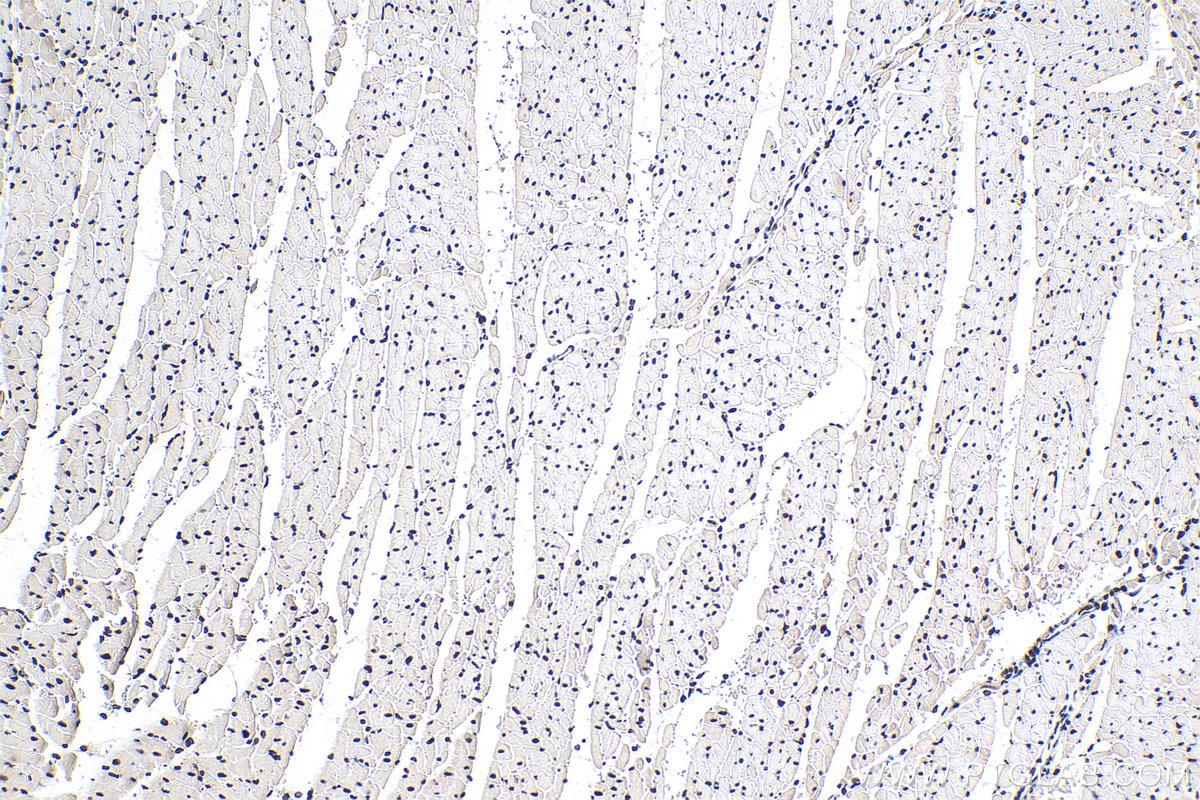Tested Applications
| Positive WB detected in | HeLa cells, HepG2 cells, HEK-293 cells, MCF-7 cells, Jurkat cells, HSC-T6 cells, NIH/3T3 cells, 4T1 cells, K-562 cells, PC-12 cells |
| Positive IP detected in | Jurkat cells |
| Positive IHC detected in | human colon tissue, human colon cancer tissue, rat heart tissue, mouse heart tissue Note: suggested antigen retrieval with TE buffer pH 9.0; (*) Alternatively, antigen retrieval may be performed with citrate buffer pH 6.0 |
| Positive IF/ICC detected in | MCF-7 cells |
Recommended dilution
| Application | Dilution |
|---|---|
| Western Blot (WB) | WB : 1:1000-1:6000 |
| Immunoprecipitation (IP) | IP : 0.5-4.0 ug for 1.0-3.0 mg of total protein lysate |
| Immunohistochemistry (IHC) | IHC : 1:500-1:2000 |
| Immunofluorescence (IF)/ICC | IF/ICC : 1:1000-1:4000 |
| It is recommended that this reagent should be titrated in each testing system to obtain optimal results. | |
| Sample-dependent, Check data in validation data gallery. | |
Published Applications
| KD/KO | See 1 publications below |
| WB | See 5 publications below |
| IHC | See 1 publications below |
| CoIP | See 1 publications below |
| RIP | See 1 publications below |
Product Information
66807-1-Ig targets PABPN1 in WB, IHC, IF/ICC, IP, CoIP, RIP, ELISA applications and shows reactivity with human, mouse, rat samples.
| Tested Reactivity | human, mouse, rat |
| Cited Reactivity | human, mouse |
| Host / Isotype | Mouse / IgG1 |
| Class | Monoclonal |
| Type | Antibody |
| Immunogen |
CatNo: Ag27470 Product name: Recombinant human PABPN1 protein Source: e coli.-derived, PET28a Tag: 6*His Domain: 94-299 aa of BC010939 Sequence: GSQEEEEEPGLVEGDPGDGAIEDPELEAIKARVREMEEEAEKLKELQNEVEKQMNMSPPPGNAGPVIMSIEEKMEADARSIYVGNVDYGATAEELEAHFHGCGSVNRVTILCDKFSGHPKGFAYIEFSDKESVRTSLALDESLFRGRQIKVIPKRTNRPGISTTDRGFPRARYRARTTNYNSSRSRFYSGFNSRPRGRVYRGRARA Predict reactive species |
| Full Name | poly(A) binding protein, nuclear 1 |
| Calculated Molecular Weight | 33 kDa |
| Observed Molecular Weight | 50-56 kDa |
| GenBank Accession Number | BC010939 |
| Gene Symbol | PABPN1 |
| Gene ID (NCBI) | 8106 |
| RRID | AB_2882150 |
| Conjugate | Unconjugated |
| Form | Liquid |
| Purification Method | Protein G purification |
| UNIPROT ID | Q86U42 |
| Storage Buffer | PBS with 0.02% sodium azide and 50% glycerol, pH 7.3. |
| Storage Conditions | Store at -20°C. Stable for one year after shipment. Aliquoting is unnecessary for -20oC storage. 20ul sizes contain 0.1% BSA. |
Background Information
Poly(A) Binding Protein Nuclear 1(PABPN1) is one of the isoforms of poly(A) binding protein (PABP) that locating to the nucleus in eukaryotic cells. And PABPN1 plays important role in mRNA stability by regulating of poly-A tail length, mRNA decay and proximal polyadenylation site (PAS) utilization at the 3'-UTR (PMID:23300856). Another report showed that PABPN1 shuttles between the nucleus and the cytoplasm to export poly(A) RNA from the nucleus (PMID:23601051). It is reported that PABPN1 is ubiquitously expressed in almost all tissues, however, mutations in PABPN1 causes Oculopharyngeal Muscular Dystrophy (OPMD) which affected in skeletal muscles specifically. Because of a mild reduction in PABPN1 levels is sufficient to induce muscle wasting (PMID:27152426). Acetylation, Methylation, Phosphoprotein are common post-translational modifications of PABPN1 protein. And 50-55 kDa bands have been reported (PMID: 29939290; 28361972).
Protocols
| Product Specific Protocols | |
|---|---|
| IF protocol for PABPN1 antibody 66807-1-Ig | Download protocol |
| IHC protocol for PABPN1 antibody 66807-1-Ig | Download protocol |
| IP protocol for PABPN1 antibody 66807-1-Ig | Download protocol |
| WB protocol for PABPN1 antibody 66807-1-Ig | Download protocol |
| Standard Protocols | |
|---|---|
| Click here to view our Standard Protocols |
Publications
| Species | Application | Title |
|---|---|---|
Cell Rep Proteomics reveal cap-dependent translation inhibitors remodel the translation machinery and translatome. | ||
Nat Cell Biol An mRNA processing pathway suppresses metastasis by governing translational control from the nucleus | ||
Cell Biosci PABPN1 regulates mRNA alternative polyadenylation to inhibit bladder cancer progression
| ||
J Biol Chem Extracellular 5'-methylthioadenosine inhibits intracellular symmetric dimethylarginine protein methylation of FUSE-element binding proteins | ||
Mol Cell The MYCN oncoprotein is an RNA-binding accessory factor of the nuclear exosome targeting complex |




























